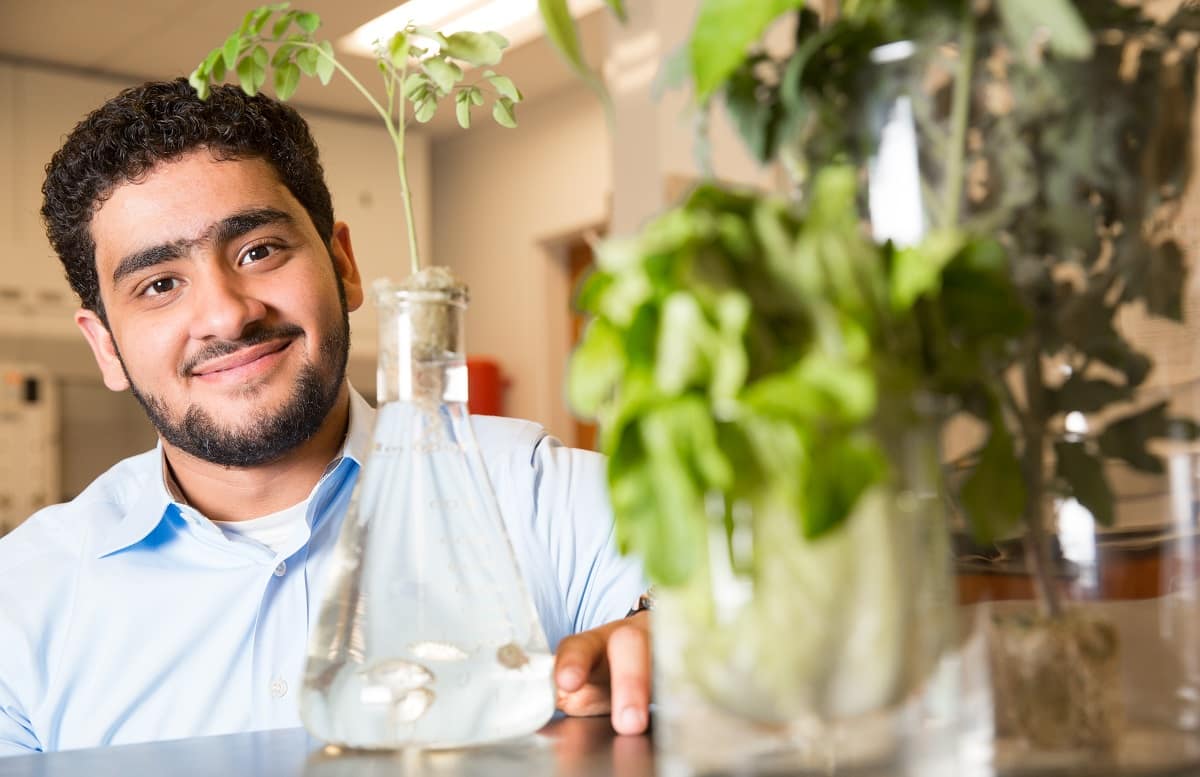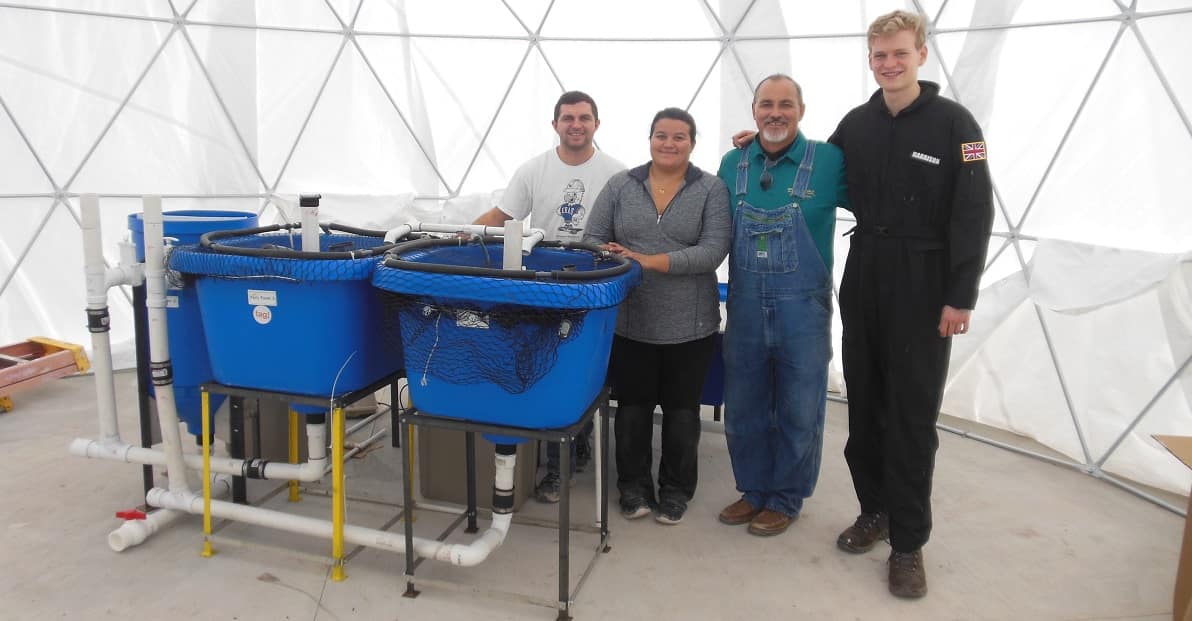Aquaponics Lab Explores Food Production for Earth And Possibly Mars

Professor Peter Merkle can envision his research, which involves networks of ecotubes full of plants, fish and fish waste, one day helping feed humans living on Mars.
“My idea is essentially to have a swamp on Mars,” he says. “We have to learn how to maintain an ecosystem off the planet Earth.”
But for now, the research being done in the Aquaponics Lab at Embry-Riddle Aeronautical University’s Daytona Beach Campus is focused on creating a more sustainable food supply here on Earth.
Aquaponics combines fish farming, known as aquaculture, with hydroponics, which involves growing plants without soil, into one integrated, mutually beneficial system.
Here’s how it works: The fish waste provides an organic, nutrient-rich fertilizer for the growing plants, and the plants act as a natural filter for the water in which the fish live. Beneficial bacteria in the aquaponics system convert the ammonia from the fish waste into nitrite and then nitrate, which fertilizes the plants. Water is cycled through the system to collect the fish waste, pump it to the plant beds, and then return it to the fish tank (see illustration on Page 23).
Aquaponics consumes minimal space and uses waste water to produce fresh, healthy food close to where people live. Indoor or enclosed aquaponics systems are inherently pesticide- and herbicide-free, and the fish waste is a natural alternative to chemical fertilizers.
“I think about the triple bottom line — environmentally sustainable, socially beneficial and economically viable,” Merkle says. “Whatever you’re doing with engineering, you’ve got to think about the triple bottom line.”
Taking Aquaponics Into the Classroom
After 17 years of conducting research at Sandia National Laboratories in New Mexico, Merkle decided to make a career change. Hired as an associate professor of civil engineering at Embry-Riddle’s Daytona Beach Campus in 2012, he built the Aquaponics Lab in 2013 with the help of his students.
“I’m interested in environmental systems, and I was struck by aquaponics as a way for students to understand an enclosed system,” says Merkle, who created one of the first aquaponics courses in the country.
The lab is also a hands-on way to help students learn about environmental processes and sustainability. In the lab, fish, such as tilapia or koi, are kept in tanks, and plants are cultivated without soil in a rigid foam raft, called a grow raft, that floats in a pool of nutrient-rich water fertilized by the fish waste. One of the plants cultivated in the lab is a species of tree, Moringa oleifera, whose leaves are highly nutritious. Merkle is exploring the plant as a possible food source for space colonists.
“I think we were the first place to grow Moringa in aquaponics back in 2013,” Merkle says.
Aquaponics systems are versatile and efficient food-growing systems. They can be built anywhere, including indoors or on top of a building. They can also be used with a variety of plants, and the fish can be harvested as a protein food source.
“Food production is very inefficient, and moving the production of food to a more accessible method is important,” Merkle says. “Indoor agriculture and agriculture on the rooftops of buildings bring the food production closer to people.”

Food for Mars
Merkle and his students are also researching the possibility of using aquaponics to produce food for future Earth colonists on Mars. “Whether we are on the moon or on Mars, the cost of bringing food would be extremely prohibitive,” Merkle says.
However, one issue with operating an aquaponics system on Mars is electricity. “The challenge is to develop a system that consumes less energy and is more sustainable,” Merkle says.
Bjorg Olafs, who graduated from Embry-Riddle in 2014, has made progress on that front. Through research she discovered a way to reduce energy consumption in an aquaponics system by 75 percent with no significant negative effect on crop or fish growth. Such a dramatic reduction in electricity demand would enable an aquaponics system to operate more economically and efficiently using solar power, a distinct advantage on Earth and a necessity on Mars, Merkle says.
“Aquaponics can be placed virtually anywhere since it does not require soil,” explains Olafs, who designed a commercial- scale aquaponics unit for a geothermally heated greenhouse during an internship in Iceland. “The possibilities are endless, even in space colonization.”
In 2015, Merkle and students Matthew Maccarrone and Connie Cuneo designed and constructed an aquaponics system at the Mars Society’s Mars Desert Research Station in Utah, an outpost where teams hold mock missions simulating the conditions on Mars. Merkle is involved in the station as a principal investigator for the GreenHab facility.
“With the increasing population, there is a higher demand for food but less and less space to grow it,” Maccarrone says. “With controlled environments like an aquaponics system, the space could be used most efficiently. This is especially true for Mars colonization.”
Growing Commercial Success
Merkle’s aquaponics course is growing more than plants; it’s helping sprout new ventures in unexpected places. Civil engineering student Mohammed Qahwaji didn’t plan to study aquaponics, but he was hooked after taking Merkle’s course. He sees aquaponics as a solution to increasing food production in his home country of Saudi Arabia.
“Aquaponics is so important to Saudi Arabia, due to its lack of rivers, rain and suitable agriculture land in many areas,” he says.
In 2015, Qahwaji created a business proposal as an assignment in Merkle’s class to start an aquaponics business in Saudi Arabia. He then entered it in the U.S. National Saudi Student Entrepreneur competition. With a minor in business administration, he placed fourth out of 200 and was promised $1.5 million in startup funding from the Saudi government.
After graduation, Qahwaji enrolled in a hands-on aquaponics course at Morningstar Fisherman in Florida, and then interned at Olomana Gardens Farms in Hawaii. In Hawaii, he visited more than 60 different aquaponics facilities, ranging from backyard setups to commercial systems, and completed a course on water chemistry in aquaponics systems at the University of Hawaii.
Wanting to start his business off small, he declined the Saudi government loan, and in 2016, he self-funded his company, which offers design, installation, maintenance, operation and consultation for home and commercial aquaponics systems. “My life has now become dedicated to aquaponics,” Qahwaji says. “All of this started with Dr. Merkle and Embry-Riddle. All my success is credited to them.”
Written by Melanie Stawicki Azam
